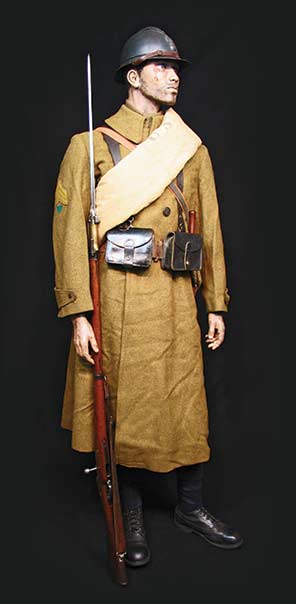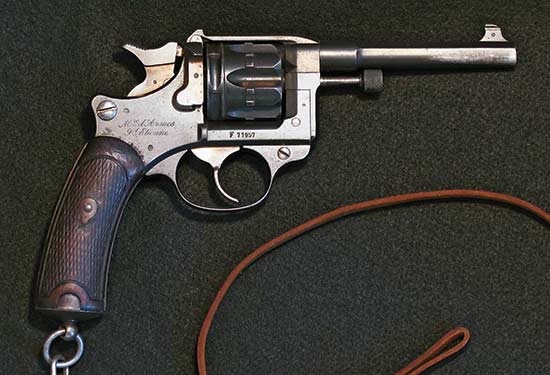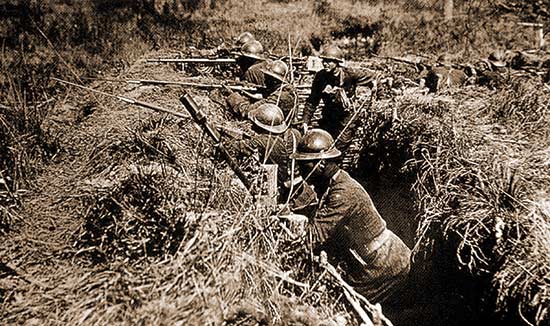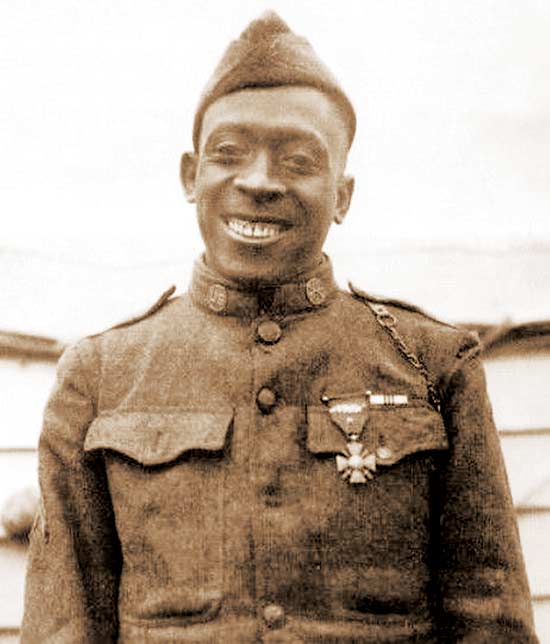The “Harlem Hellfighters”
Pvt. Henry “Black Death” Johnson And The 369th US Infantry Earned Battle Honors During WWI

Under French command, the 369th received Mle 1907-15 Berthier Infantry rifles. An extended
5-round magazine was introduced late in the war, but never displaced all of the rifles with 3-round
magazines. The Épée-Baïonnette Modèle 1886 Modifié 1915 was a modified version of the Mle 1886
Lebel épée bladed thrusting bayonet, lovingly referred to by the French Poilu’s as “Rosalie.” The Mle
1907-15 was easier and less expensive to produce than the Mle 1886-93 Lebel. The new 1915 bayonet
was a simplified version of the earlier Lebel’s. Simplification included removal of the of the curved quillion,
grips made of brass and, later in the war, grips of steel. [Below] The Mousqueton de Artillerie Modèle 1892
with the Sabre-Baïonnette Modèle 1892 was a handy carbine issued to the members of crew-served weapons.
However, as the hand grenade gradually displaced the full-length infantry rifle late in the war, its diminutive length
made it the firearm of choice in the confines of the trenches among bombing parties of Grenadiers.
Outpost 20, May 14, 1918, 2 a.m. Pvt. Henry Johnson and Pvt. Needham Roberts were manning the forward observation post in the Argonne Forest in the Champagne Sector on the Western Front when hell broke loose. Both Johnson and Roberts were severely wounded at the outset of the fight. Roberts’ hip and arm were mangled by a German hand grenade from the opening volley of the attack, while Johnson was shot three times with a pistol and received another 18 wounds from grenade fragments.
Pvt. Johnson was the first American soldier awarded the Croix de Guerre with star and bronze palm, the highest honor of the French military for valor. Pvt. Roberts was the second American so honored. This extraordinary display of courage and ferocity was also the basis upon which Pvt. Henry “Black Death” Johnson received his nickname. An African-American soldier in a “white man’s US Army,” Pvt. Johnson and his comrades amazingly enough were serving in the frontline trenches as part of the French 16th Division.
The 369th US Infantry was originally formed as the 15th New York National Guard Infantry Regiment, but had their official designation changed when they were federalized to form one of the four African-American regiments forming the 93rd Infantry Division of the American Expeditionary Force. The 93rd Division included the 369th, 370th, 371st and 372nd Infantry Regiments, all of which were composed entirely of African-American troops with both black and white officers. The 93rd was among the very first US divisions sent to France, arriving at Brest on December 27th, 1917.
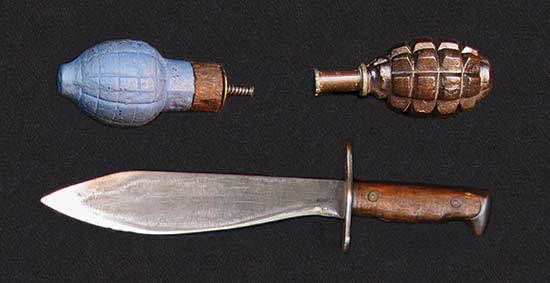
The two hand grenades most likely employed by Johnson and Roberts in the frenzied combat
at Outpost 20 include the Citron Foug Modèle 1916 (left, painted Horizon Blue) and the F1 Modèle
1915, both with percussion fuses. The M1915 weighed 630 grams with 60 grams of cheddite, a type
of explosive developed in France in 1897. The M1916 tipped the scales at 550 grams with a charge of
90 grams of cheddite. Pvt. Johnson also carried his US-issued M1910 Bolo Knife, and used it with telling effect!
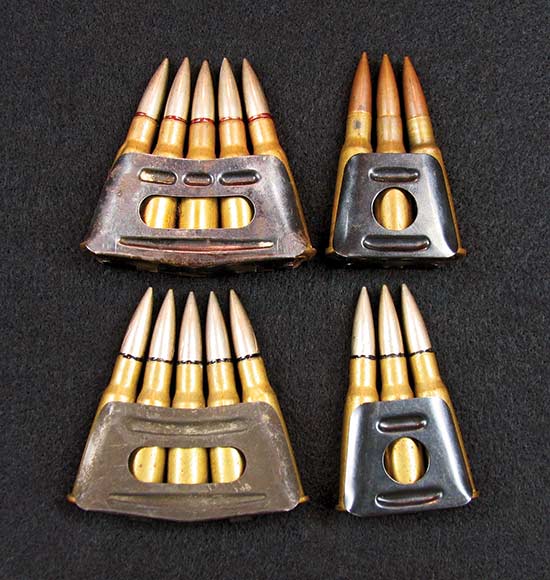
The French seriously handicapped themselves going to war with 3-round Mannlicher enbloc
clips for the Berthier. Later, the rifles were modified with a larger magazine to use 5-round enbloc
clips. The 8x50mmR cartridges with steel jacketed bullets are post-war “Balle N” ammunition. The
3-rounds in the clip in the upper right hand corner are “Balle D” cartridges manufactured during WWI.
With the US Army policy of segregation, the vast majority of the 380,000 African-American soldiers who served during the war never saw combat, but instead were organized into work battalions to perform manual labor in the form of road and bridge building, fortification construction, the building of artillery emplacements and other essential non-combat duties.
The French, on the other hand, had utilized African colonial troops in a combat role all during the war and were well aware of their ability to fight. Short of replacements after 3 long years of bitter warfare in the trenches of the Western Front, the French high command had badgered US General “Blackjack” Pershing for replacement troops. Both the French and British military were pressing Pershing to assign the newly arrived American units as replacements to be fed piecemeal into the existing French and British Divisions fighting in the frontline trenches.
Pershing resisted, and rightfully so, insisting American forces fight as an independent stand-alone Army holding their own sectors of the trenches on the Western Front. However, in order to placate the French, he agreed to second the African-American 93rd Division to the French Army, which was then broken up into four separate replacement regiments, each serving within different French Divisions. The 369th Infantry Regiment was incorporated in the French 16th Division when they first entered the line. Later in the war they would be reassigned to the 161st French Division.
The four US Infantry African-American regiments serving with the French Army remained under the command of their own officers, who in turn reported within the French chain of command in their assigned Divisions. During their brief period training in the USA and upon their arrival in France, the members of the 369th were issued P17 Enfields, standard issue US M1910 web equipment and the M1917 “Brodies” helmets. These were patterned after the British design introduced in 1915 as the “helmet, steel, Mk I.” Once transferred under French command, the troops retained their uniforms. However, to ease re-supply they were issued French weapons, equipment and Mle 1915 Adrian helmets.
The standard issue rifle supplied by the French was the Mle 1907-15 Berthier along with the Épée-Baïonnette Modèle 1886 Modifié 1915. The Mle 1907-15 was a full-length infantry rifle and had evolved during the war from the Fusil de Tirailleur Sénégalais “Colonial” Modéle 1907. The full-length rifles featured the same Berthier designed action introduced in various carbine models in 1890. The rifle was loaded with 3-round Mannlicher enbloc clips. Upon firing the last round, the fresh 3-round clip was pushed down into the action, forcing the empty clip out of the action through a rectangular opening in the bottom of the magazine. The Mle 1907-15 Berthier’s primary drawback was the 3-round capacity of its Mannlicher enbloc fed magazine. A new 5-round magazine was introduced in 1916 but the new variation didn’t see active service until late 1917.
The heavy MG sections of the 369th were issued the reliable Hotchkiss Mle 1914 machine-gun chambered for the 8x50mmR “Balle D” round, the same tapered cartridge known to cause some of the reliability problems encountered with the complicated gas-operated, blow-forward design of the St. Étienne Mle 1907 machinegun. The Mle 1914 Hotchkiss MG’s 24-round sheetmetal strips could be continuously fed into the action by attaching a new loaded strip of cartridges to the end of the strip passing through the action during firing.
The mobile fire support teams were issued the ubiquitous (infamous) “Fusil Mitrailleur Modéle 1915 CSRG” better known as the Mle 1915 Chauchat. This ungainly, sheetmetal-stamped automatic rifle has gained a very bad reputation over the years regarding reliability. However, it is important to point out the Mle 1918 Chauchat manufactured for the AEF in the final year of the war was chambered for the .30-06 cartridge.
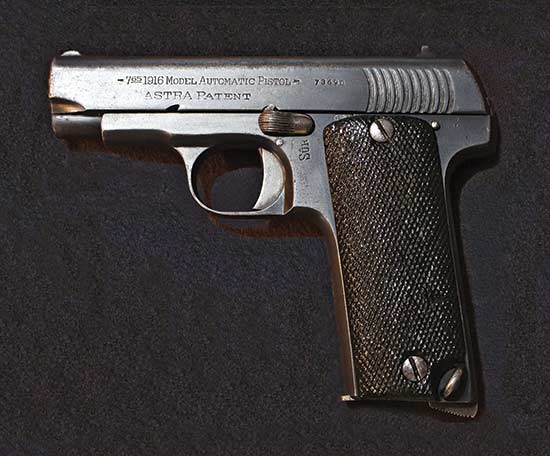
Based on the system of the M1903 Browning, the Ruby was produced in large numbers in
Spain on contract for the French Army. The pistol’s compact size and reliability, combined
with the 9-round magazine, won popular approval among the soldiers issued one in spite of
the marginal stopping power of its .32 ACP cartridge.
The US cartridge worked at far higher chamber pressure than the CSRG was designed for, and the already problematic 1/2-moon magazine for the chunky 8mm proved equally unsuitable for the .30-06 as well. This resulted in the development of a new magazine for the version of the Chauchat chambered in .30-06. In the end, the majority of “Fusil Mitrailleur Modéle 1915 CSRG” US troops actually carried into battle was the standard issue French version in the 8x50mmR cartridge.
In addition, the issues with the original Mle 1915 chambered for the French cartridge were to a great degree due to the design and quality of the magazines. The extreme taper created when the French based the cartridge case design of the 8x50mmR smokeless cartridge on its black-powder predecessor, the 11x59mmR, greatly affected the design of the magazines. The only magazine design accommodating a reasonable amount of ammunition was semi-circular in shape. This had a direct effect on the proper functioning of the follower spring. Worse still was one of the design features of the magazines. To allow the gunner to quickly assess how many rounds remained in the magazine, there were two lateral cutouts in the right side of each 20-round mag. This feature proved to be a nightmare as mud, dirt and debris could easily enter the magazine through these slots, contributing to constant jamming. Combined with weak follower springs and magazine quality control problems, constant stoppages were the norm.
While it’s important to note the Mle 1915 CSRG became the doormat of automatic weapons critique ever since the Great War, during the war an experienced gunner developed skills to trouble-shoot problems. Coaxed into action, the mobile firepower provided by fire support teams armed with the CSRG held the enemy at bay more often than not. If ever there was a vote of confidence in the weapon, it can be found in late war group photos of German Sturmtruppen armed with captured Chauchats! Between 1915 and the end of the war in November 1918, a total of 262,000 of the Mle 1915 CSRG were produced. Had the weapon been as bad as its detractors make it out to be, production would never have reached this number.
Soldiers of the 369th assigned to crew-served weapons were issued the Mousqueton de Artillerie Modèle 1892 and the Sabre-Baïonnette Modèle 1892. The short, handy carbines easily slung across the soldier’s back keeping both hands free.
While the higher-ranking officers of the “Harlem Hellfighters” retained their standard issue semi-automatic Colt M1911.45’s, French-issue handguns were issued to some members of the crew-served weapons. While the French employed a wide variety of different handguns during the war, the most likely candidates for issue to the 369th were the Mle 1892 Ordnance Revolver and the M1915 Ruby designed and manufactured in Spain.
The M1892 revolver was a sturdy, well designed, solid-frame, double-action handgun chambered for an 8mm round with ballistics similar to the .32 ACP cartridge. The swing-out cylinder held 6 rounds. Empty cases could be simultaneously ejected by depressing the ejector rod. The handy revolver weighed slightly less than 2 pounds.
The Ruby—“Pistolet Automatique de 7.65mm”—was a small, compact, reliable semi-auto pistol based on Browning’s M1903 design. The Ruby was manufactured by a wide variety of Spanish firms under contract from the French. It was the standard issue sidearm for the Mle 1915 Chauchat gunners. Chambered for the .32 ACP, each magazine held 9 rounds.
Nowhere in any of the surviving documents, or the after-action testimony provided by Pvt.’s Johnson and Roberts following their harrowing experience, does it state exactly which hand grenades were employed by them to such good effect. However, based on the primary grenades in French service at the time, they were undoubtedly either the F1 Modèle 1915 or the Citron Foug Modèle 1916. Both were fragmentation grenades used extensively by the French, the Imperial Russian Army, the Serbian Army and the AEF as provided by France.
Both models were initially issued with a percussion fuse. A safety cap covered the fuse of both models while in transport or prior to their use in the field. In combat, the cap was removed, exposing the stem of the percussion fuse. To arm the grenade the stem was struck against a hard surface that fired a percussion cap which in turn ignited a 5-second fuse. Beginning in 1916 the newly designed Modèle 1916 Billant time-delay fuse was used extensively with the F1 Modèle 1915 grenade. This fuse included a pin, spoon and striker that everyone today would recognize as the basic design incorporated in countless different grenades ever since. The Citron Foug Modèle 1916 remained in use with the original percussion fuse. It was less expensive to produce and as such, was manufactured in huge numbers.
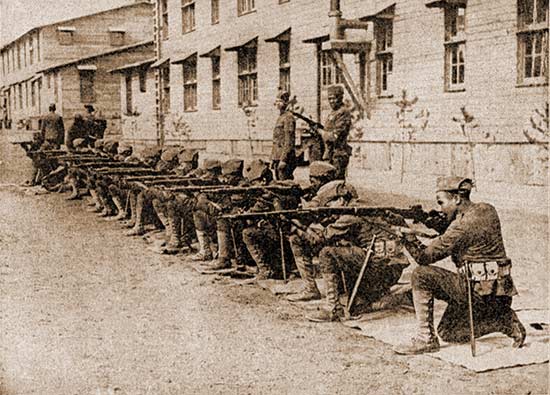
African-American troops of the AEF training behind the lines in France (above). Note this
squad is still armed with their issue US M1917 Enfields. This amazing photo (below) was originally
presented as having been taken in the frontline trenches during combat. While it was most likely
taken during training, it still provides an excellent study of the French weapons issued to the celebrated
369th while in French service. The soldier in the foreground with the cup-discharger prepares to fire a
“VB” rifle grenade. The two soldiers beyond are loading their Mle 1907-15 Berthier Infantry Rifles, bayonets
fixed, with 3-round enbloc clips. The fourth soldier is taking aim with his Mle 1915 CSRG “Chauchat” deployed
on its built-in bipod. Just beyond the gunner is a member of his team standing by with a fully loaded magazine
at the ready for a quick reload. An officer of unknown rank stands behind them with pistol in hand.
Rifle Grenades
By the time the 369th “Harlem Hellfighters” entered the line with the French 16th Division, the French Army was already fielding the finest, most effective rifle grenade of the war, the Viven-Bessière simply referred to as the “VB” rifle grenade. The system was designed in 1916 and saw general service from 1917 until the end of the war. The ingenious design was fired via a cup-discharger mounted on the muzzle of an Mle 1886-93 Lebel Infantry Rifle.
Rather than relying on a special blank cartridge to generate the necessary gas propulsion to launch the grenade, the “VB” was fired with a standard rifle cartridge. The design featured a hole lined with a brass tube that passed clear through the center of the cast iron body of the grenade from bottom to top. The “VB” was dropped down the center of the cup-discharger where the hole in the grenade aligned with the bore of the rifle.
When the rifle was fired, the bullet was forced through the hole in the center of the body of the grenade. At the top of the hole was a trip wire that when struck by the bullet, armed the fuse. The bullet squeezing through the brass tube in combination with the blast of gas generated by the powder charge in the cartridge propelled the “VB” grenade to a maximum range of 180 meters! The “VB” was extremely safe to use, which was not the case with many of the earlier grenades used during the war. It provided a tremendous amount of mobile firepower and had a profound effect on company level tactics. By 1917 each company included 16 Grenadier teams trained in the use of the “VB” rifle grenade.
The 369th “Harlem Hellfighters” as they became known, went on to hold the distinction of having spent more days in actual combat than any other regiment in the AEF. When the Armistice went into effect on the 11th hour of the 11th day of the 11th month of the final year of the war, the 369th had spent 191 days in the frontline trenches. They won distinction at the Battles of Château-Thierry and Belleau Wood as well as in countless other actions.
They were the very first Allied Regiment to reach the Rhine. The “Harlem Hellfighters” became one of the most highly decorated American units to have served in the war with 171 of its officers and men having received individual medals, while the Regiment received a Croix de Guerre with silver star for taking the heavily defended town of Sechault.
During their 191 days in the line, the 369th never lost a soldier to capture, suffered more than 1,500 casualties while only receiving 900 replacements and the regiment never yielded a foot of ground while in combat.
After The War
Henry Johnson was promoted to the rank of Sergeant and, upon return to the United States in 1919, he proudly rode in an automobile at the head of the 369th “Harlem Hellfighters” New York City Victory Parade down 5th Avenue.
Before the war Henry Johnson had worked as a railroad porter in Albany, New York. Sgt. Johnson returned to his previous job as a Red Cap porter, however, he was plagued with physical maladies due to the wounds he had sustained in combat. He drifted from one job to the next and eventually turned to alcohol. Eventually, his wife and three children left him. He died a pauper in 1929, a one-time hero long forgotten. The mountain of paperwork following the AEF to France and back, compounded by the fact the 369th had fought under French command, further complicated by the color of his skin, denied him the disability pension he rightfully deserved.
In 1996 Johnson was belatedly awarded the Purple Heart, and in 2002 he received the Distinguished Service Cross. Finally, on June 2nd, 2015 President Barrack Obama posthumously awarded the Medal of Honor to Sgt. Henry Johnson. The ceremony was conducted 96 years, 11 months and 17 days after “Black Death” Johnson exhibited courage above and beyond the call of duty in the finest tradition of the United States Army.
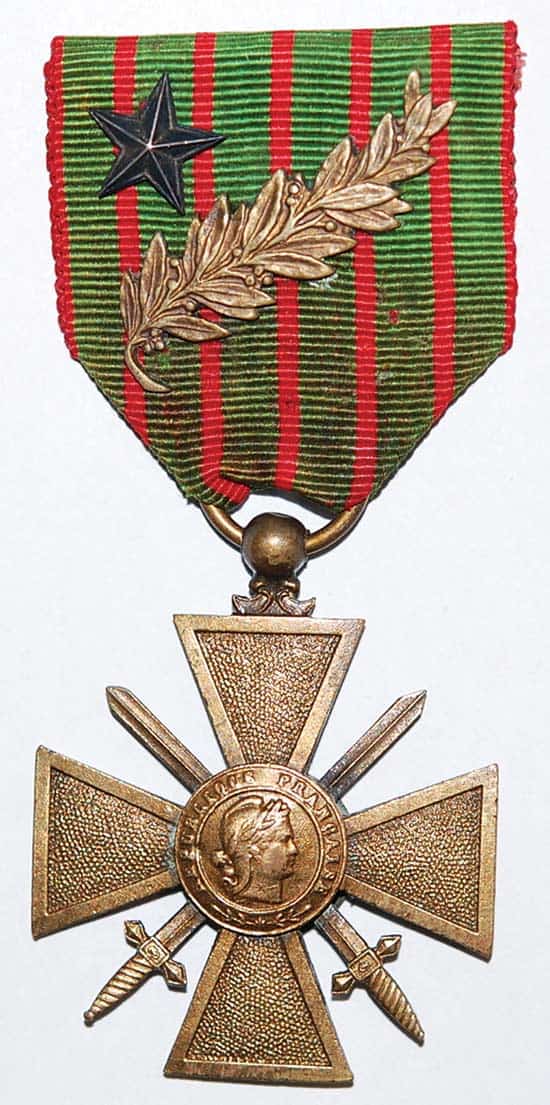
France’s Croix de Guerre was first introduced in April 1915 in order to help boost morale as a
Medal of Valor for an individual soldier’s heroism. The translation is “Cross of War” and the
addition of silver and/or bronze stars and palm leaves on the medal’s ribbon further defined the
level upon which the medal was awarded. The Croix de Guerre was awarded soldiers of allied
countries fighting alongside the French as well.
Original Citation
An excerpt from the letter written by Colonel William Hayward, CO, 369th US Infantry, to Mrs. Edna Johnson, the wife of the then Pvt. William Henry Johnson.
“At the beginning of the attack the Germans fired a volley of bullets and grenades and both boys were wounded, your husband three times and Roberts twice… In spite of their wounds, the two boys waited coolly and courageously and when the Germans were within striking distance opened fire… But the German raiding party came on in spite of their wounded and in a few seconds our boys were at grips with the terrible foe in a desperate hand-to-hand encounter, in which the enemy outnumbered them 10 to one… Roberts was overpowered and about to be carried away when your husband, who had used up all of the cartridges in the magazine of his rifle and had knocked one German down with the butt end of it, drew his Bolo from his belt. A Bolo is a short heavy weapon carried by the American soldier, with the edge of a razor, the weight of a cleaver and the point of a butcher knife… fighting desperately, opened with his Bolo the head of the German who was throttling Roberts, and turned to the Boche who had Roberts by the feet, plunging the Bolo into the German’s bowels. Henry laid about him right and left with his heavy knife, and Roberts, released from the grasp of the scoundrels, began throwing hand grenades, and exploded them in their midst….”


